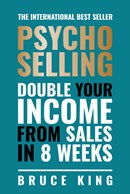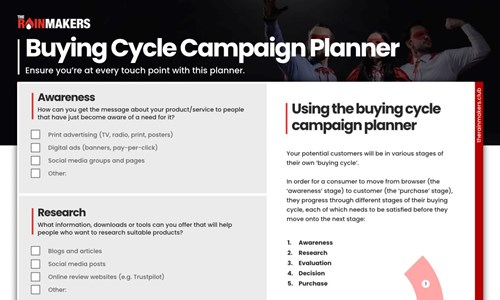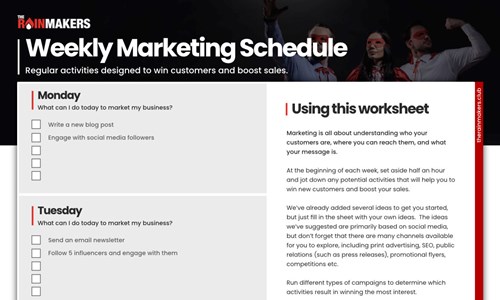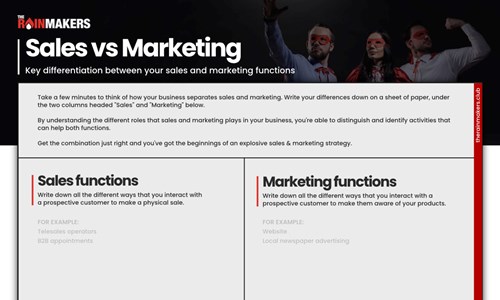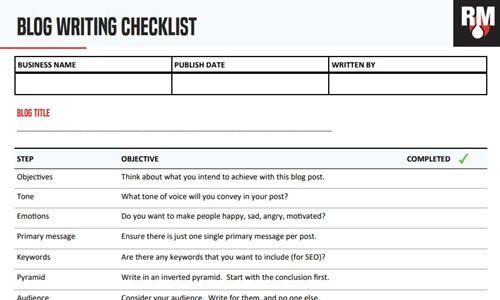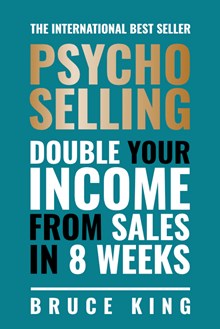DOUBLE YOUR INCOME IN JUST 8 WEEKS
Download this all-time classic bestselling book from Bruce King free.


The Four Concepts Of Psychology In Marketing: Needs, Wants, Demands And Desires
By Chris Haycock | 27 April 2023
What makes people tick? More importantly, what makes people reach for their wallet? Let's find out how the four concepts of marketing psychology can help you win more customers and grow your business.
Back in 1943 Abraham Maslow published a theory that explores what specific needs people have as they try to reach their full potential. He turned these needs into a pyramid, with the basic needs at the bottom, and the higher needs at the top.
Let's take an average person. Her basic needs are food, water, and shelter. Once those are met, the person moves up the pyramid. - as each need is fulfilled, they progress up the levels, which include safety, love, self-esteem, accomplishment etc. - at the top of the pyramid there is self-actualisation and self-transcendence, which really means achieving your full potential in life. Maslow was obviously a clever man. He understood how the human mind works, and how we all have a desire - a need - to better ourselves. He realised that in order to better ourselves, we have "specific needs" that need to be addressed. Whilst it has been disputed over the last three quarters of a century, it's still an important piece of work that's referred back to time after time. There is a tonne of research into the workings of his theory, so if you're interested, just Google Maslow's Hierarchy of Needs. It's really fascinating stuff for those interested in human psychology. For anyone involved in marketing, there is a need to understand a fair bit of psychology, in order to determine exactly what our customers need - or want - or desire. Marketing is a complex field that requires understanding of what makes humans tick. Needs, wants, demands and desires are four essential concepts in marketing psychology that must be understood to successfully reach an audience. But what exactly do these terms mean? How can they help marketers craft effective strategies? In this post we'll break down each concept step-by-step so you can apply them to your own campaigns with confidence. Before diving in, it's helpful to know why understanding psychological principles matters for modern marketers. Well, it all comes down to knowing how people think and behave when presented with certain messages or products. Understanding needs, wants, demands and desires allows us to tap into those subconscious processes more effectively than ever before - creating ads, marketing campaigns, copy, and materials that speak directly to our target market's deepest motivations.Definition Of Psychology In Marketing
Psychology in marketing is the study of how people think, feel and act when it comes to buying products or services. It's as simple as that. And there's no need to take a university degree to understand what makes customers reach for their wallets. The concepts are really easy to understand. Marketing psychology examines their motivations, aspirations, needs, wants and desires. It's about understanding human nature, so that marketers can better target their customers' interests, enabling businesses to create far more successful advertising campaigns. Psychology helps us get into our customers' heads... and ask "what really makes them tick"? "What are they looking for from a brand or product"? "How do we meet those expectations"? By unlocking these secrets, companies can build relationships with their audience based on trust and loyalty, leading to more sales and conversions further down the line.Understanding Human Nature
Now let's look at how understanding human nature can help us better understand those customer needs, wants, demands and desires. As I mentioned earlier in this post with Maslow's Hierarchy of Needs, we all (with no exceptions) have a basic need for food, water and shelter; these are our most fundamental requirements to survive. Wants on the other hand refer to something that we do not necessarily need for survival but still desire to own or experience. For example wanting a new pair of shoes is a want since it does not directly affect your ability to live. Demands then come into play when consumers actively demand certain goods or services from businesses due their strong preferences for them. Our desires often go even further than needs and wants, as they may be based upon dreaming about having things beyond our immediate reach. In other words, something that we can aspire to own. Desires also include such abstract concepts as love, happiness and fulfilment, which cannot always be bought with money alone. Now that we have examined the four main concepts of psychologies in marketing - needs, wants, demands and desires – we can move onto looking at the difference between 'needs' and 'wants'.Difference Between Needs And Wants
Needs are the things (which may be tangible or not) that a person must have in order to survive or maintain their health and well-being. Wants, on the other hand, refer to items that someone would like to have, but does not necessarily need. For example, food is an essential need for survival while luxury cars are merely a want. Needs can be further broken down into two categories: physiological needs such as air, water, and food; and psychological needs such as security and self-esteem. Physiological needs take precedence over all other types of needs because without them we cannot survive. Psychological needs are important too, though they become more prominent when our basic physical requirements are met. Wants come in many shapes and sizes. They may range from small everyday luxuries such as a jar of Nescafe coffee or bar of Snickers, to larger desires like owning a second home or going on a luxury holiday to The Maldives. What separates wants from needs is that one can generally live without them, whereas with many needs you cannot go without them completely. Let's move onto another concept related to marketing - demands and desires...Distinction Between Demands And Desires
The distinction between demands and desires is subtle but quite important. Demands refer to the items or services that people feel they need in order to survive, while desires are more aspirational, because they represent products and experiences that people may want but do not necessarily require for their day-to-day lives. Both of them have an effect on consumer buying behaviour in different ways, which is why it's important to understand the difference between them. When consumers demand something, they view it as essential, and will be willing to pay whatever price necessary to get their hands on the product or service. Some examples could include necessities such as food, clothing and shelter. On the other hand, when someone has a desire for something, they can often justify spending money on it even if its cost exceeds what might be considered reasonable because of how much value they place upon it. Examples of this could range from dreaming of buying a brand new Aston Martin all the way down to the latest fancy coffee drinks at Starbucks. In terms of marketing strategies, understanding the differences between needs, wants, demands and desires helps you target customers in more effective ways. For instance, offering discounts on products that meet basic needs can help satisfy those who simply require an item out of necessity whereas creating incentives around desirable goods may attract buyers seeking extra pleasure or satisfaction through their purchases. When you think about it, it makes complete sense. It's all about providing options tailored specifically towards your audience’s mindset at any given point in time, so that you can maximise selling potential with each advertisement or campaign you decide to run. Ultimately, getting inside your customer’s head by focusing on both their practical concerns as well as their ambitions and aspirations gives you greater insight into their purchasing behaviours, allowing you to craft campaigns that cater directly to their individual preferences. The alternative is to try to speak broadly across multiple demographics at once (the 'scattergun approach') to marketing. And - to be honest - with this knowledge of consumer behaviour, running marketing campaigns become easier (and more fun) to get your head around!Role Of Perception In Decision-Making
DOUBLE, TRIPLE, OR QUADRUPLE YOUR SALES
Join other small business owners who are benefiting from new sales & marketing skills.
Influences Of Attitudes On Purchasing Decisions
The way we think and feel about things can have a major influence on our purchasing decisions. Yes, that's pretty obvious already, but you'd be surprised how many business owners don't take into account what people feel. Usually, they make decisions based on what they - as a business owner - feel, which is the wrong approach. That’s why pro marketers focus on attitudes when trying to persuade consumers to buy their products or services. Attitudes are formed from beliefs, values and opinions that shape how people view the world around them. We all have different attitudes toward buying certain items and these will be shaped by past experiences as well as external influences such as family, friends, advertising and media messages. When it comes to reaching for the wallet, people with positive attitudes towards a product or service may be more likely to purchase it than those who have negative feelings. For example, someone who believes in sustainability might choose an eco-friendly car over one that is pumping fumes into the air. On the other hand, someone who isn't convinced of the value of organic food might opt for processed foods instead. That's their choice, of course. But in both cases, attitude has been shown to affect purchasing behaviour in some way. Our attitudes can also determine how much money we spend on certain products or services. People with strong opinions about quality tend to pay higher prices for better goods and services than those without. Likewise, shoppers who are price conscious will search for bargains before committing to any particular item. So whether you're looking for a new car or just need a small basket of groceries for tonight's family dinner, stop and consider your attitude first! You'll learn a lot about consumer behaviour when you understand your own feelings as a consumer too.Effects Of Learning On Consumer Habits
It's no secret that consumer behaviour is heavily influenced by learning. We learn from our environment, from advertisements, from our own -and other people’s - experiences. This can have a huge impact on the way we make buying decisions. Consumer habits are formed over time based on their level of understanding regarding the product offering. The more they know about a particular item, the more likely they will purchase it if offered at a competitive price point relative to perceived value received. Often, we do this subconsciously - or at least with very little thought involved. Personally, I quite like a couple of bottles of Peroni as I'm cooking my evening dinner. I've learned over time that it doesn't really make me feel too groggy if I go a little mad and have an extra couple, so I'll pick up a case on occasion. But there are far cheaper beers out there that are equally as good, so I tend to pay for those instead. However, when I see there's money off a case of Peroni, my previous learned behaviour means that I'll reach for the Peroni and treat myself. As we - as marketers continue to understand how consumers learn about products and services, there will always be room for growth in driving brand loyalty with meaningful messaging that drives this learned behaviour, as long as we know why and what that learned behaviour is.Concept Of Brand Loyalty
Now that we've discussed the effects of learning on consumer habits, let's take a look at the concept of brand loyalty. Brand loyalty is one way for businesses to build strong relationships with their customers. The idea is to create a situation where the customer keeps coming back for more - the holy grail! Brand loyalty fits perfectly in this article, because it involves understanding customer needs, wants, demands, and desires in order to create an emotional connection between the customer and the product or service being offered. A quick refresher, if you've made it this far. Needs are basic requirements such as food, shelter, clothing etc., while wants are products or services desired by consumers which can be fulfilled through marketing strategies. Demands refer to items that people purchase regularly when they become available in the market; these goods may include things like smartphones, cars, appliances etc. Lastly, desires are intangible elements aroused within individuals due to various factors such as advertising campaigns or celebrity endorsements. If companies can understand what drives a customer’s purchasing decisions then they will be able to deliver more efficient products and services tailored towards them. With proper implementation of all four concepts mentioned above – needs, wants, demands and desires - it is possible for businesses to cultivate long-term relationships with their customers. As we all know, this will drive increased sales and profits over time.Significance Of Cognitive Dissonance In Marketing
As we know, needs, wants, demands and desires all play an important role in making sure that customers buy what they believe will bring them satisfaction. Cognitive dissonance is the idea that we don't always make decisions based on logic or reason; sometimes our emotions get involved too. We may want something because it, well, just looks good or feels right, even if it doesn't meet our criteria for being sensible or practical. I'm sure that psychologists will have a field day on this, but for us marketers, it's something that even though we need to understand, it's a feeling that we just can't put our finger on. Sometimes, our final choice is irrational or downright daft. But it almost always come down to what emotions we're feeling at the time. Marketers must capitalise on how people feel about certain products by creating emotional connections with their brands. They need to appeal to both sides of the customer’s brain: the rational side that takes into account needs and logical considerations as well as the emotional side which is driven by feelings and desires. The challenge lies in striking a balance between meeting consumer needs while also providing them with experiences that move beyond just satisfying basic requirements - ones that engage on an emotional level as well. People have come to expect more from brands than ever before so companies need to take extra care when crafting messaging and product design in order to stand out from competitors and capture attention. This requires creativity coupled with data-driven insights in order to understand what truly resonates with potential buyers in order to foster strong relationships over time.The Key Takeaway
Marketing psychology is a powerful tool that can be used to understand human nature and their preferences. It helps marketers gain insight into the various needs, wants, demands, and desires of consumers which allows them to create strategies more effectively. When you get inside a customer's mind, and walk in their shoes to understand what's happening inside their minds, marketers can craft campaigns that appeal to customers on an emotional level, making it easier for them to purchase products. And the bottom line is this... this knowledge can only increase your sales - and your bank balance too!---

There's more inside The Rainmakers Club
Ready to double, triple or even quadruple your sales? Join the Rainmakers Club today and get access to hundreds more worksheets, ebooks, tutorials, guides, tools and downloads.
NEW FOR 2022! Join our growing club of successful small business owners and get The Raindeck free: a 3-deck strategy for brainstorming and running successful marketing campaigns.
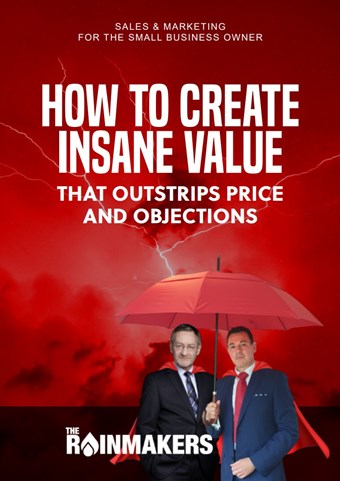
HOW TO CREATE INSANE VALUE
A must-have read for anyone that sells anything
Discover techniques and methods that will increase your product's perceived value - without having to change your product or prices.
Get the book freeGET STARTED WITH
The Rainmakers
Join today for the price of your daily cup of Mocha coffee, and become a sales and marketing giant.
Learn sales & marketing
Double, triple, or quadruple your sales and income.
Expert mentoring
Learn from renowned sales and marketing experts.
Exclusive resource library
Tools, downloads, cheat sheets and worksheets to help you succeed.
Free Raindeck strategy box
Brainstorm, plan and execute brilliant marketing campaigns in no time.


